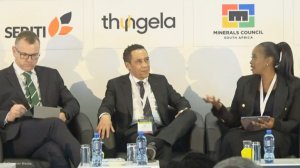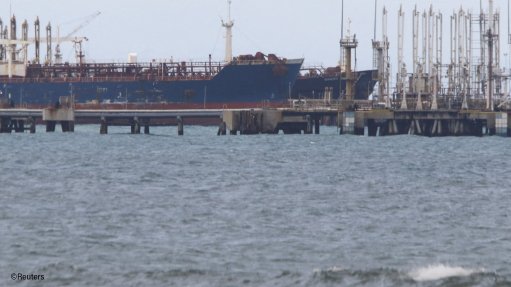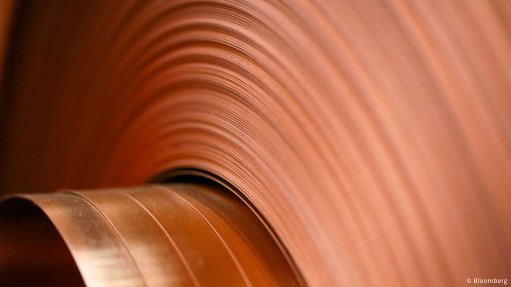Seriti’s wind move may be further energy transitioned by solar, Coal & Energy Day hears

Coal & Energy Transition Day covered by Mining Weekly's Martin Creamer. Video: Darlene Creamer.
JOHANNESBURG (miningweekly.com) – Black-owned coal mining company Seriti Resources' advance into wind energy through Seriti Green may be further advanced by an entry into solar power, Tuesday’s Coal & Energy Transition Day 2024 was told.
Moreover, it was also made clear by event chairperson and mining luminary Bernard Swanepoel and reiterated by facilitator and EY partner Thabi Malatji that next year’s event would have transitioned to something like 'energy transition day', with the word 'coal' being removed from the title, and added conversation on clean, green energy on the programme. (Also watch attached Creamer Media video.)
As Seriti Resources CEO Mike Teke outlined, Seriti acquired its domestic New Denmark, Kriel and New Vaal coal mines and New Largo project from a coal-divesting Anglo American.
The second part was to acquire the coal assets from a coal-divesting South32, which put Seriti in a position to export coal.
“It became important for us then to think about the future of coal and as part of our strategy, we decided that we are an energy business, we're not a coal business. We want to play in the energy space,” Teke explained at the event covered by Mining Weekly.
“We were fortunate to come across an asset called Windlab,” the company headed by Peter Venn, who is now CEO of Seriti Green.
“We had a conversation, we shook hands, and the transaction happened,” Teke recalled.
This has already resulted in the first-phase construction of the R4.8-billion 155 MW wind energy facility being implemented in Mpumalanga, South Africa’s coal province, and a lot more is on the way, with solar power also now on the energy transition list.
WIND TURBINE IMPROVEMENT
The improvement on wind turbines in the last 10 years has been around material sciences.
The world has advanced from one megawatt turbines in 2013 to now being able to comfortably deploy an eight-megawatt turbine.
“So, eight times growth, but it's fundamentally about the material science. We now have towers in Mpumalanga of 130 m, and the blades are 91 m,” said Venn.
“Artificial Intelligence plays an important part. Our construction team lives in Bethal, there's very little wind. You drive to site 20 km away, and there's lots of wind. So, you need to go where the wind is.”
WHOLESALE ENERGY MARKET ON WAY
Regarding the market for independent power producers (IPPs), Venn spoke of the customers being big industrial players.
“Then there's the emergence of energy traders. There's comfortably between 10 and 15 energy traders. One that's been very much talked about recently is Discovery Green, part of the Discovery Group.
“Fundamentally, Discovery Green has got a great technology platform, and they’re going to be able to take energy from IPPs like ourselves, and then disseminate that to very small customers because of their tech platform.
“On our side, we need 15-to-20-year contracts for electricity to allow us to build the capital plants, whereas for Discovery Green, you can be a customer of theirs on a monthly basis.
“So, we're seeing big industrials, we're seeing traders, and I think over the next five years, and particularly with the new national transmission company, we're going to start seeing a wholesale market for electricity that's really going to change things.
“Then we're going to see the pricing of Eskom’s plant and I’ll be able to arm wrestle around what are the true prices per kilowatt hour of a coal plant versus a wind plant versus a solar plant. But obviously, we need balancing etc., to make sure that we’re delivering what the customers need at the end of the day.
“Is it peak energy, is it 24 by seven, and this will be borne out as more energy efficiency programmes are created and as the tariff structure changes, with regards to charging people more for peak electricity.
“At the moment, homes have a flat rate 24 hours, and it's absolute craziness to get home and to charge your car at 6pm, whereas you can just press three buttons and charge it at 3am. There's no disincentive now for that, and we need to get a little bit of that type of thinking in the policies.
“The best way is to have a disincentive through tariff, where you're charged several times more to charge your car in evening peak,” said Venn.
Malatji: Could you unpack what you feel will be required or would be needed from a stakeholder participation perspective, to get the energy transition journey going?
Venn: We can either go the top-down or the bottom-up route on this. If I speak about the bottom-up approach to start, we've had fantastic engagement with local municipalities in Mpumalanga. We've been adopted by local municipalities. They are truly supporting us, from the police captain to the fire chief. The mayor has a monthly meeting on our project alone. From the top down, fundamentally it's around the top changing the municipal model, to change the income of municipalities. We’re seeing it with City Power’s R200 a month charge here in Johannesburg. Municipalities must start charging for infrastructure. If you’re connected to the grid, but not using a kilowatt hour, you still need to pay for your connection. Otherwise, why should you have that wire? Is City Power going to come and take the wire away from you? Municipalities have to start moving to this type of capacity charge, but it's not what we, as citizens of this country, are used to.
Article Enquiry
Email Article
Save Article
Feedback
To advertise email advertising@creamermedia.co.za or click here
Press Office
Announcements
What's On
Subscribe to improve your user experience...
Option 1 (equivalent of R125 a month):
Receive a weekly copy of Creamer Media's Engineering News & Mining Weekly magazine
(print copy for those in South Africa and e-magazine for those outside of South Africa)
Receive daily email newsletters
Access to full search results
Access archive of magazine back copies
Access to Projects in Progress
Access to ONE Research Report of your choice in PDF format
Option 2 (equivalent of R375 a month):
All benefits from Option 1
PLUS
Access to Creamer Media's Research Channel Africa for ALL Research Reports, in PDF format, on various industrial and mining sectors
including Electricity; Water; Energy Transition; Hydrogen; Roads, Rail and Ports; Coal; Gold; Platinum; Battery Metals; etc.
Already a subscriber?
Forgotten your password?
Receive weekly copy of Creamer Media's Engineering News & Mining Weekly magazine (print copy for those in South Africa and e-magazine for those outside of South Africa)
➕
Recieve daily email newsletters
➕
Access to full search results
➕
Access archive of magazine back copies
➕
Access to Projects in Progress
➕
Access to ONE Research Report of your choice in PDF format
RESEARCH CHANNEL AFRICA
R4500 (equivalent of R375 a month)
SUBSCRIBEAll benefits from Option 1
➕
Access to Creamer Media's Research Channel Africa for ALL Research Reports on various industrial and mining sectors, in PDF format, including on:
Electricity
➕
Water
➕
Energy Transition
➕
Hydrogen
➕
Roads, Rail and Ports
➕
Coal
➕
Gold
➕
Platinum
➕
Battery Metals
➕
etc.
Receive all benefits from Option 1 or Option 2 delivered to numerous people at your company
➕
Multiple User names and Passwords for simultaneous log-ins
➕
Intranet integration access to all in your organisation

















